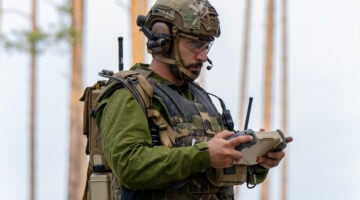
WASHINGTON: In wartime, the cost of gas is often partly paid in blood. Hundreds of US troops have died and thousands have been wounded fighting to move supplies in Afghanistan and Iraq. Against an adversary with long-range missiles like Russia, the carnage among convoys would be worse.

The bulkiest cargo and often the most needed (along with bullets and bombs): fuel. If you could dramatically reduce the amount of gas the US military consumes, you could reduce the logistics burden a great deal. Fewer fuel convoys on the road would save money in peacetime and lives in wartime. But how do you get there?
With electric vehicles, answers Lt. Gen. Eric Wesley, head of the Futures & Concepts Center at Army Futures Command.
“Tesla is building large [semitrailer] trucks,” he told reporters in a wide-ranging roundtable yesterday. “Battery costs have gone down precipitously over the last 10 years,” he said, recharge times have dropped, and ranges has grown longer. What’s more, electric motors have many fewer moving parts than internal combustion ones, making them potentially easier to maintain and repair.
“The entire automotive industry is migrating towards this idea of electrification,” he said. “We’re already, I would argue, late to the need.”
Not only do electric motors not need gas, Wesley said. They also can generate power for high-tech combat systems – sensors, command networks, even laser weapons and robots – that currently require dedicated auxiliary power units or diesel generators that burn even more fuel. Imagine a squad of soldiers recharging their jamming-resistant radios and IVAS targeting goggles in their vehicle between missions, or a mobile command post running its servers off the same truck that carried them.
The Hard Part
Electric motors can even help frontline forces sneak up on the enemy, he said. They run much quieter and cooler than internal combustion engines, making it much harder to hear electric vehicles approaching or spot them on infrared.

Now, Wesley isn’t talking about electric tanks, just trucks. “Right now, we don’t see the technology, on the near-term horizon, being able to power heavy vehicles,” he said. That’s because even the latest batteries still provide less power per pound than fossil fuel. (Engineers call this “energy density”). So, for example, the replacement for the Reagan-era M2 Bradley troop carrier – likely to weigh about 50 tons — is going to need an internal combustion engine or at least a hybrid diesel-electric one. But the vast majority of Army vehicles are wheeled, from supply trucks to the JLTV, an armored 4×4 replacing many Humvees: That weight class, up to 10 or even 15 tons, can move on electrical power alone.
Wesley had planned to kick off his electrification drive with a panel discussion at last month’s AUSA Global Force Symposium in Huntsville, Ala. (I would’ve been the moderator). But that conference got canceled due to the COVID-19 coronavirus, so he’s rolling it out to the press instead. His staff is working on an in-depth internal study for his boss, the four-star chief of Army Futures Command, Gen. John “Mike” Murray.
There are a lot of thorny problems to work out, Wesley acknowledges. The big one: Where do you generate the electricity in the first place? In a war zone, you can’t just pull into your garage and plug into a charger overnight.

“We can’t just go buy an electric vehicle. We have to look at the supply chains,” he said. One option the Army’s considering, he said, is miniaturized, mobile nuclear power plants – something the Pentagon is now researching and says should be safe even after a direct hit.
While Wesley didn’t discuss other alternatives, the fallback option is presumably burning some fossil fuel to run a generator, which then charges batteries or capacitators.
“We’re writing a draft white paper proposal for Gen. Murray and the Army to look at this holistically,” Wesley said, “[and] we are building up a proposal that we will publish here in early summer that is going to describe a recommendation for how the Army transitions toward the future.”
“My expectation is that it’s about a 10-year horizon right now to do something like that which I just described,” he said. “If that’s true, then we have to have a transition plan for the Army to move in this direction.”
Extended excerpts from Lt. Gen. Wesley’s roundtable with reporters, edited for length & clarity, follow below. He also discussed how Army units have to evolve for future multi-domain operations: more on that later this week.

Q: The Army’s been interested in electric vehicles and alternative fuel for some time. What’s new here?
A: We were going to have a panel on this to kick off [at AUSA Global Force]: a broader look at electrification and alternative fuel sources for the Army. We’re writing a draft white paper proposal for Gen. Murray and the Army to look at this holistically. And we are building up a proposal that we will publish here in early summer that is going to describe a recommendation for how the Army transitions toward the future.

Tesla is building large [semitrailer] trucks. UPS and FedEx are starting to buy these vehicles to learn how they move into that area. The entire automotive industry is migrating towards this idea of electrification, and there’s a lot of good reasons for it. And as the entire industry goes to electrification, the supply of internal combustion engine parts is going to go down and therefore prices are going to go up.
Battery costs have gone down precipitously over the last 10 years. Recharge times and range [have improved]. The trajectory that all of that is on, in the next two years, it’ll be far more efficient to have an electric vehicle than internal combustion, so we’re already, I would argue, late to the need.
Q: What’s slowed the Army down?
A: The problem is bigger for the Army than it is for any corporation, industry, or family, because you have to have a means to move the energy and generate the energy at the right time and place. It’s not that the Army is slow to move on this, we just have a bigger problem to solve, and I would argue that’s what we have to do now.
The issue is not whether we can build hybrid vehicles. That’s easy. In fact, any one of us could go out and — as long as there’s not a waiting list — buy a Tesla tomorrow and sell our Chevy Suburban. You plug it in at home, we’ve got the infrastructure. You don’t have to change your supply chain or your way of life when you buy a Tesla.
The Army, we can’t just go buy an electric vehicle, we have to look at the supply chains. How are you going to have [electricity] sources for charging?
If technology tells us that safe, mobile nuclear power plants, for example, something that goes on the back of a truck, are realistic, and if you add capacitor technology [to store the electricity], you can distribute that forward in varying ways.
Q: Are we talking about electric-drive tanks here? Or just trucks?
A: The Army hasn’t said, we’re going all-electric. Right now, we don’t see the technology, on the near-term horizon, being able to power heavy vehicles, it’s just too much of a drain on the battery. The Next Generation Combat Vehicle, it’s still going to require you to have an internal combustion engine.
But if we could reduce the fossil fuel consumption by transitioning our wheeled vehicles [to electric motors], you can reduce the volume of travel on your supply route to only [move] fossil fuels for the much heavier vehicles.

Q: Could you make an electric version of something like the Joint Light Tactical Vehicle?
A: The technology to power a vehicle of that weight exists today. We’re talking [up to] about 10-15 tons; that technology exists now.
If it exists now, you can anticipate that we’re going to have to transition some of this in the next 10 years. And if that’s true, then we have to have a transition plan for the Army to move in this direction.
It should require a very detailed strategy and step by step pathways. It should include starting to build in hooks into our requirements [for new designs]. And then there are other experimentation efforts where we can learn about enterprise-level supply chain decisions.
(Eds. note: We ask all fans of Phillip K. Dick to forgive us for the headline).

